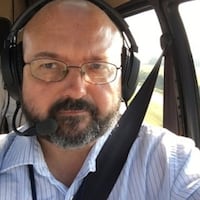“I talk to my wife a lot,” Mims said through a bullhorn near the intersection of West Third and North Wilkinson streets. “She says, ‘You guys (veterans) should not have to fight for anything. You should not want for anything.’”
Cheryl Walden, who has worked as a registered nurse for 27 years and a VA nurse for eight years, works as a call center nurse taking calls from veterans experiencing medical and sometimes mental health emergencies. On weekends and holidays, Walden said, such nurses can take calls from veterans in seven states.
Sometimes, she said, only two or three clinical call center nurses are available, at times late at night, and at times when a veteran is experiencing a crisis.
“Now a veteran can wait 30 minutes for a nurse,” she said. “So any further cuts are going to increase that wait time.”
The group tried to enter the federal building at 120 W. Third St., where Turner, a Republican, has one of his local offices.
As a group climbed the steps to the building’s door, a federal security worker immediately opened the door and ordered them to stop. He told the group they could appoint no more than two representatives to meet with Turner’s staff.
A spokeswoman for Turner said two protesters met with Turner’s VA case worker and Frank DeBrosse, Turner’s deputy chief of staff.
Staffing shortages at Veterans Health Administration (VHA) facilities nationally rose 50% in the last fiscal year, according to an inspector general’s report released this summer.
In fiscal year 2025, VHA facilities reported a total of 4,434 “severe” occupational staffing shortages nationally, a 50% increase from the previous fiscal year, in which facilities reported 2,959 total shortage occupations, the IG stated.
Staffing shortages at the Dayton VA Medical Center include clinical medical officers in the fields of urology, surgery, cardiovascular diseases, radiology, medical oncology and other medical areas, the report indicated.
In July, the VA said it was on pace to reduce its number of employees nationally by nearly 30,000 by the end of September, the end of the federal government’s fiscal year.
The reduction eliminated the need for a large-scale reduction-in-force, the VA said then.
About two weeks later, VA Deputy Secretary Paul Lawrence said in a visit to Dayton that talk of a nationwide “reduction in force” was in the past.
In fact, the VA is hiring in select areas, he said.
“We are not cutting benefits,” Lawrence said in July. “If anything, it’s just the opposite. We’re taking the savings from the actions we’ve previously (taken), hiring more doctors, hiring more nurses, hiring people who adjudicate our benefits claims, so that we can provide better care to our veterans.”
Since January, the backlog of veterans waiting for VA benefits is down more than 37%, the department has said.
Since Jan. 20, the VA has offered veterans nearly 1 million appointments outside of normal operating hours and has opened 16 health care clinics across the nation.
In May, the department said it exempted more than 300 Veterans Health Administration job descriptions from a hiring freeze, including nine support positions at the Veterans Crisis Line.
About the Author



